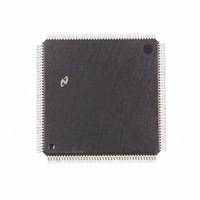DP83934CVUL-33 National Semiconductor, DP83934CVUL-33 Datasheet - Page 90

DP83934CVUL-33
Manufacturer Part Number
DP83934CVUL-33
Description
IC CTRLR ORIENT NETWORK 160PQFP
Manufacturer
National Semiconductor
Datasheet
1.DP83934AVQB.pdf
(104 pages)
Specifications of DP83934CVUL-33
Controller Type
Network Interface Controller (NIC)
Interface
Twisted Pair
Voltage - Supply
4.75 V ~ 5.25 V
Current - Supply
140mA
Operating Temperature
0°C ~ 70°C
Mounting Type
Surface Mount
Package / Case
160-MQFP, 160-PQFP
Lead Free Status / RoHS Status
Contains lead / RoHS non-compliant
Other names
*DP83934CVUL-33
Available stocks
Company
Part Number
Manufacturer
Quantity
Price
Company:
Part Number:
DP83934CVUL-33
Manufacturer:
Texas Instruments
Quantity:
10 000
9 0 AC and DC Specifications
MEMORY ARBITRATION SLAVE ACCESS
Note 1 Both CS and MREQ must not be asserted concurrently If these signals are successively asserted there must be at least two bus clocks between the
deasserting and asserting edges of these signals
Note 2 It is not necessary to meet the setup times for MREQ or CS since these signals are asynchronously sampled Meeting the setup time for these signals
however makes it possible to use T60 to determine exactly when SMACK will be asserted
Note 3 T60 could range from 1 bus clock minimum to 5 bus clock maximum depending on what state machine the SONIC-T is when the CS or MREQ signal is
asserted This timing is not tested but is guaranteed by design This specification assumes that CS or MREQ is asserted before the falling edge that these signals
are asynchronously clocked in on (see T56 and T58) SAS must have been asserted for this timing to be correct See SAS and CS timing in the Register Read and
Register Write timing specificaitons
Note 4 bcyc
Note 5 The way in which SMACK is asserted due to CS is not the same as the way in which SMACK is asserted due to MREQ SMACK goes low as a direct result
of the assertion of MREQ whereas for CS SAS must also be driven low (BMODE
when SMACK is asserted due to MREQ SMACK will remain asserted until MREQ is deasserted Multiple memory accesses can be made to the shared memory
without SMACK ever going high When SMACK is asserted due to CS however SMACK will only remain low as long as SAS is also low (BMODE
(BMODE
important difference to consider when designing shared memory designs
Number
T56
T58
T60
T80
T81
e
0) SMACK will not remain low throughout multiple register accesses to the SONIC-T because SAS must toggle for each register access This is an
e
bus clock cycle time (T3)
CS Low Asynchronous Setup to BSCK
(Note 2)
MREQ Low Asynchronous Setup to BSCK
(Note 2)
MREQ or CS Valid to SMACK Low
(Notes 3 4)
MREQ to SMACK High
BSCK to SMACK Low
Parameter
(Continued)
90
e
1) or high (BMODE
Min
8
8
1
20 MHz
Max
18
22
5
e
0) before SMACK will be asserted This means that
Min
7
7
1
25 MHz
Max
16
20
5
TL F 11719 – 71
e
1) or high
Units
bcyc
ns
ns
ns
ns











